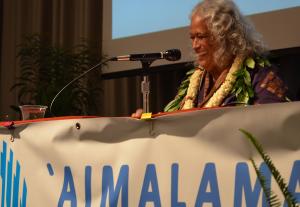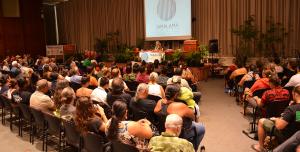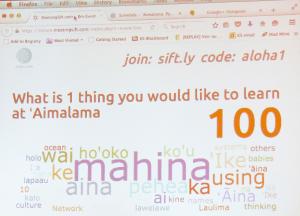Lunar conference on climate change launched on UH Manoa campus
University of Hawaiʻi at MānoaDirector of Strategic Partnerships, School of Hawaiian Knowledge
Lilinoe Andrews, (808) 220-3359
Assistant Specialist, School of Hawaiian Knowledge
Hundreds of cultural experts, scientists and community leaders convened last week at the East-West Center on the UH Mānoa campus to apply the use of the traditional lunar calendar and explore how ancestral knowledge can address and mitigate the impacts of climate change.
The ʻAimalama conference, which featured panel discussions, site trips and presentations, was launched by Dr. Pualani Kanaka‘ole Kanahele, a revered Hawaiian cultural practitioner, retired UH associate professor, kumu hula and co-founder of the Edith Kanaka‘ole Foundation.
“The Hawaiian lunar calendar is knowledge that belongs to Hawaiians,” Kanahele said. “The traditional lunar calendar is older than Hawaiians. It is ancient wisdom and therefore belongs to the People of the Pacific. The ‘Aimalama Lunar Conference brought this ancient wisdom to the forefront for us to update our knowledge today, so that we can create new knowledge for the future and share it with the world.”
Findings from the conference will comprise a report to be carried forward by indigenous peoples that include conference presentations and policy recommendations based on traditional methodologies. This report will inform negotiations at the upcoming 21st Session of the Conference of the Parties to the United Nations Framework Convention on Climate Change (COP21/CMP11), otherwise known as “Paris 2015,” from November 30 to December 11, the International Union for Conservation of Nature World Conservation Congress in Honolulu next year, as well as other pertinent international meetings such as the United Nations Convention on Biological Diversity.
The report will feature Pacific native people’s lunar methodologies and highlight how they are used to identify indicators of climate change occurring in the Pacific and adaptive measures to prepare for it.
Many Pacific societies are currently reviving and reconnecting with the traditional lunar calendar to restore traditional knowledge related to agricultural productivity, marine and forest gathering, resource management, health and healing, and daily practices that provide sustenance for the health and well-being of communities.
“We stand at the intersection of ancestral knowledge and technological transformation in order to identify a common ground from which to confront regional and global challenges,” said conference co-founder Mālia Nobrega-Olivera, director of strategic partnerships and community engagement at the Hawaiʻinuiākea School of Hawaiian Knowledge.
Nobrega-Olivera employed technology to increase the reach and impact of the conference. Handouts were provided via mobile devices, remote groups or “hub sites” throughout Hawaiʻi and abroad. In addition, there was participation throughout the conference via Facebook and Google Hangouts, and the real-time, interactive meeting software, MeetingSift, was used to make the conference sessions more productive and impactful.
For more information, go to http://www.aimalama.org



